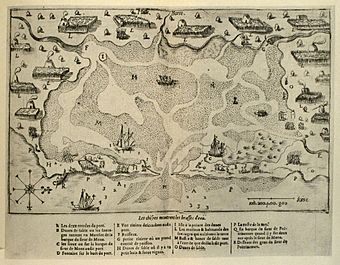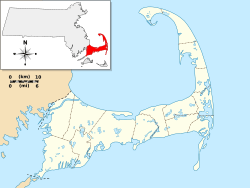Nauset Archeological District facts for kids
|
Nauset Archeological District
|
|
|
U.S. Historic district
Contributing property |
|

A 1605 map showing Nauset Harbor lined with the wigwams of the Nauset tribe
|
|
| Location | Eastham, Massachusetts |
|---|---|
| Built | 4,000 B.C. |
| Part of | Fort Hill Rural Historic District (ID00001656) |
| NRHP reference No. | 93000607 |
Quick facts for kids Significant dates |
|
| Added to NRHP | April 19, 1993 |
| Designated NHLD | April 19, 1993 |
| Designated CP | April 5, 2001 |
The Nauset Archaeological District is a special historical area in Eastham, Massachusetts. It is also known as the "Coast Guard Beach Site" or "North Salt Pond Site." This district is part of the Cape Cod National Seashore. It holds the remains of very old settlements that date back to at least 4,000 BC.
Contents
Discovering the Nauset People
Who were the Nauset?
The first written record of this area comes from Samuel de Champlain in 1605. He was a French explorer who sailed into a bay here. Champlain saw many wigwams belonging to the Nauset tribe. His map, shown in the infobox, even shows these wigwams.
Life in the Nauset Village
Champlain's notes tell us a lot about the Nauset people. They grew crops like corn, beans, squash, and tobacco. Their homes were round wigwams covered with woven reeds. They made clothes from grasses, hemp, and animal skins.
The Nauset people were also skilled fishers. Champlain's map shows a special fishing tool. It was a cone-shaped weir made from saplings and grass rope. This weir helped them catch fish swimming from the marsh into a pond. For farming, they used tools made of stone and hardened wood.
How Many People Lived There?
Around 150 people lived near Nauset Harbor. Another 500 to 600 people lived south of there, near Stage Harbor. This area is now Chatham, Massachusetts. Studies show that these settlements were lived in all year long.
Changes After European Contact
Early Encounters with English Colonists
After 1620, English colonists from Plymouth, Massachusetts often visited Nauset. They came to buy food and trade goods. However, the Europeans also brought new diseases. The Nauset people had never been exposed to these illnesses. Sadly, many Nauset people became sick and their population greatly decreased.
English Settlers Arrive
In 1639, about half of the English settlers from Plymouth moved to the Nauset area. They started a new town there. This town is known today as Eastham, Massachusetts.
Visiting the Nauset Archaeological District
The Nauset Archaeological District was added to the National Register of Historic Places in 1993. You can visit this important historical site today. It is part of the Fort Hill area of the Cape Cod National Seashore. You can find it off U. S. Route 6.
There are trails like the Fort Hill and Red Maple Swamp trails. These trails wind from the top of the hill down to the marsh. They offer a chance to explore this ancient land.




